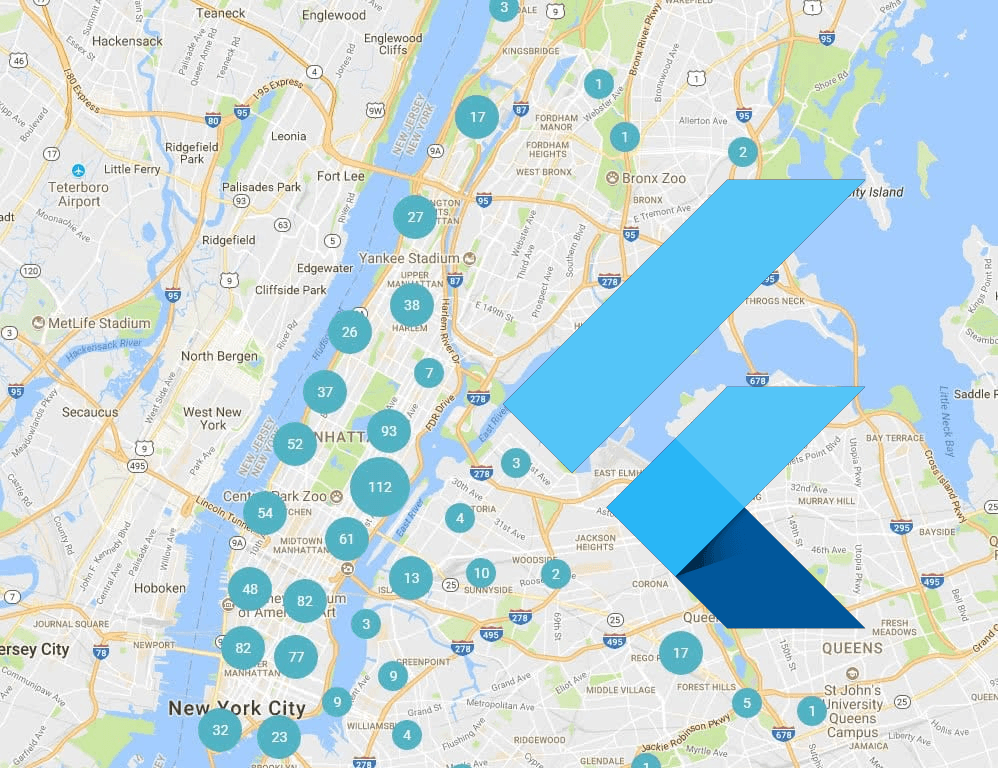Flutter/Google Maps/
How to integrate google maps in flutter ?
2022-10-17T09:34:04.580794Z
Published on

Introduction:
Google Maps Flutter plugin is provided in the Google Map widget that supports initialCameraPosition, maptype, and onMapCreated. We can set the position of the camera and marker in any place on the earth. We can design the marker according to our choice. It also comes with a zoom property in a cameraposition to provide the zooming-in google map view on the initial page
Flow diagram:

Prerequisites :
Google cloud account ( https://console.cloud.google.com )
Plugin used :
google_maps_flutter: ^2.1.12( google_maps_flutter | Flutter Package )
google_maps_flutter | Flutter Package )
Steps :
Step 1: Signup / Login Google Cloud
If you don't have an Google Cloud account (https://console.cloud.google.com ), please proceed with the signup option. otherwise, log in with your existing credentials.
Step 2: Create a project in Google Cloud
In the Google Cloud dashboard click Select a project

It prompts a popup, In that popup click NEW PROJECT

On the next page fill project name and click CREATE

Step 3: Enable map SDK
In the Google Cloud dashboard Select a project (i.e. Created in Step 3 : Create a project in Google Cloud )
After selecting your project go to APIs and services > Library

On the next page, click Maps SDK for Android (Based on your device Android or iOS)

On the next page click ENABLE

Step 4: To retrieve the API key
In the Google Cloud dashboard Select a project (i.e. Created in Step 3 : Create a project in Google Cloud )
After selecting your project go to APIs and services > Credentials
Click on CREATE CREDENTIALS > API key.
You will get a popup with an API key

Initially, the restrictions will be set to None. If you want to restrict your key,
In the dashboard Navigate to APIs and services > Credentials > click Edit API key

On the next page fill the following details
In Application restrictions > choose Android apps (based on your device Android or iOS)

In Restrict usage to your Android apps click ADD AN ITEM.
Add your package name(i.e. In your flutter Project’s AndroidManifest.xml file
package="com.example.map_project")Add your SHA-1 certificate fingerprint.
To generate a SHA-1 certificate fingerprint. In Android studio terminal navigate to your project directory and run the following command
for windows
1keytool -list -v -keystore "%USERPROFILE%\.android\debug.keystore" -alias androiddebugkey -storepass android -keypass androidfor Linux or macOS
1keytool -list -v -keystore ~/.android/debug.keystore -alias androiddebugkey -storepass android -keypass android
Copy the SHA-1 certificate fingerprint. Add your SHA-1 certificate fingerprint and click DONE

In API restrictions choose to Restrict key
In the select APIs dropdown select Map SDK for Android. click OK > SAVE
If Map SDK is not in the list, you have to enable it first.

Step 5: Create a Flutter project
Open Android Studio and go to File > New > New Flutter Project

It prompts a popup. In that popup, browse your Flutter SDK installation path and click Next

On the next popup fill project name, project location and click Finish

Create a dart file named current_loaction.dart under the lib folder.
The final project structure is given below

Step 6: Add plugin in flutter project
Add the
google_maps_flutter: ^2.1.12package in your pubspec.yml and runpub getFor Android
Set the
minSdkVersioninandroid/app/build.gradle:1android { 2 defaultConfig { 3 minSdkVersion 20 4 } 5}.

Specify your API key(i.e. created in Step 5: To retrieve the API key) in the application manifest
android/app/src/main/AndroidManifest.xml:1<manifest ... 2 <application ... 3 <meta-data android:name="com.google.android.geo.API_KEY" 4 android:value="YOUR KEY HERE"/>also, add permission to use location in
AndroidManifest.xml:1<manifest ... 2<uses-permission android:name="android.permission.ACCESS_FINE_LOCATION" /> 3 <uses-permission android:name="android.permission.ACCESS_COARSE_LOCATION" /> 4 <uses-permission android:name="android.permission.INTERNET"/>.

Step 7: Using GoogleMap widget
As part of the google maps integration on this project, we are using
geolocator: ^9.0.1plugin to get the current location.In main.dart – get the
latitudeandlongitudevalues using geolocator.
A sample main.dart file can be found in the following git repository file.
In current_location.dart – Using the
latitudeandlongitudevalues we will get the location in google Maps.
1GoogleMap(
2 onMapCreated: _onMapCreated,
3 initialCameraPosition: CameraPosition(
4 target: LatLng(double.parse(Lat) , double.parse(Lng)),
5 zoom: 20.0,
6 ),
7 )
onMapCreated – This method is called on map creation and takes a MapController as a parameter.
initialCameraPosition – This gives the starting position of the map when it is opened for the first time.
A sample current_location.dart file can be found in the following git repository file.
Complete Flutter example in the following github repo.
Result :
After run the app , If we click on the Get current location button, we will get the current location. See the below image:


Comments
